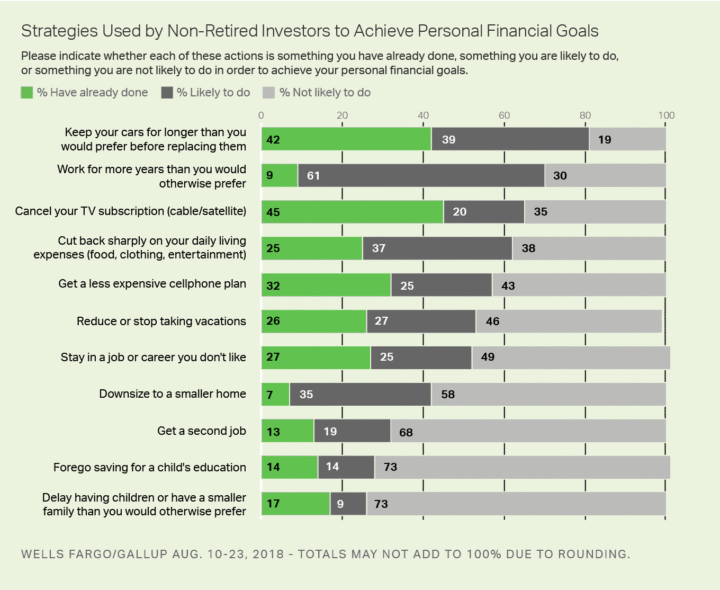According to a Wells Fargo/Gallup survey of U.S. investors, 78% say they are at least fairly disciplined in reaching their financial goals. About 50% of investors say they will have to sacrifice a “fair amount” or “a lot” to reach their financial goals, while the other half only expects to sacrifice “only a little” or “nothing”. Investors are defined as adults with $10,000 or more invested in stocks, bonds or mutual funds, either within or outside of a retirement savings account.
In what areas do they expect to sacrifice? Here is a chart showing the most popular ways in which the polled investors say they have and/or expect to sacrifice to reach their personal financial goals:

 The Best Credit Card Bonus Offers – 2025
The Best Credit Card Bonus Offers – 2025 Big List of Free Stocks from Brokerage Apps
Big List of Free Stocks from Brokerage Apps Best Interest Rates on Cash - 2025
Best Interest Rates on Cash - 2025 Free Credit Scores x 3 + Free Credit Monitoring
Free Credit Scores x 3 + Free Credit Monitoring Best No Fee 0% APR Balance Transfer Offers
Best No Fee 0% APR Balance Transfer Offers Little-Known Cellular Data Plans That Can Save Big Money
Little-Known Cellular Data Plans That Can Save Big Money How To Haggle Your Cable or Direct TV Bill
How To Haggle Your Cable or Direct TV Bill Big List of Free Consumer Data Reports (Credit, Rent, Work)
Big List of Free Consumer Data Reports (Credit, Rent, Work)
I have been driving a 1995 Saturn since 2002 which now has 298,000 miles on it. Last Friday, I bought another 1995 Saturn with 65K miles. One of the biggest mistakes that I see people make with money is with cars. Either they don’t take care of them/fix them themselves, or they upgrade them for prestige or to “save money” on repairs. Newer cars usually come with higher monthly costs in the form of loans, insurance, and registration. If you need one, I get that, but I have coworkers who at 45 have just paid off a car only to get a second one on a loan. If I drive this new car to 100K miles, which will take about 5 years, it will have cost me more in insurance per month than payments, not to mention the insurance, taxes, and registration are lower on a beater car. It’s a car. If you are defined by your things, then people don’t usually like you; they like your things.
I drove a used 2002 Saturn from 2012-2015. Great car, heated seats, leather interior, and good gas mileage. $4000 paid for the car, sold for about $2000.
After that I bought a new 2015 Mazda 3 with cash. $20,800 out the door price. It’s been extremely reliable and a pleasure to drive. Nearly 60k miles on it after 4.5 years. I’m definitely more inclined to buy new and drive it for 10-15 years rather than gamble on used again.
I agree! I prefer having a new car, knowing everything is new than gambling on a used one that I have no idea on how it was really handled by the previous owner.